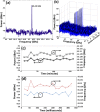Towards 5G: A Photonic Based Millimeter Wave Signal Generation for Applying in 5G Access Fronthaul
- PMID: 26814621
- PMCID: PMC4728612
- DOI: 10.1038/srep19891
Towards 5G: A Photonic Based Millimeter Wave Signal Generation for Applying in 5G Access Fronthaul
Erratum in
-
Author Correction: Towards 5G: A Photonic Based Millimeter Wave Signal Generation for Applying in 5G Access Fronthaul.Sci Rep. 2020 Jul 22;10(1):12147. doi: 10.1038/s41598-020-69377-1. Sci Rep. 2020. PMID: 32699388 Free PMC article.
Abstract
5G communications require a multi Gb/s data transmission in its small cells. For this purpose millimeter wave (mm-wave) RF signals are the best solutions to be utilized for high speed data transmission. Generation of these high frequency RF signals is challenging in electrical domain therefore photonic generation of these signals is more studied. In this work, a photonic based simple and robust method for generating millimeter waves applicable in 5G access fronthaul is presented. Besides generating of the mm-wave signal in the 60 GHz frequency band the radio over fiber (RoF) system for transmission of orthogonal frequency division multiplexing (OFDM) with 5 GHz bandwidth is presented. For the purpose of wireless transmission for 5G application the required antenna is designed and developed. The total system performance in one small cell was studied and the error vector magnitude (EVM) of the system was evaluated.
Figures










Similar articles
-
Millimeter-wave radio-over-fiber system using optical phase modulation and photonic downconversion for uplink fronthaul transmission.Opt Lett. 2021 May 15;46(10):2493-2496. doi: 10.1364/OL.425267. Opt Lett. 2021. PMID: 33988617
-
Hybrid fiber-THz fronthaul supporting up to 16384-QAM-OFDM with the delta-sigma modulation.Opt Lett. 2022 Sep 1;47(17):4307-4310. doi: 10.1364/OL.466080. Opt Lett. 2022. PMID: 36048640
-
InAs/InP quantum dash buried heterostructure mode-locked laser for high capacity fiber-wireless integrated 5G new radio fronthaul systems.Opt Express. 2021 May 24;29(11):16164-16174. doi: 10.1364/OE.424504. Opt Express. 2021. PMID: 34154184
-
The benefits of convergence.Philos Trans A Math Phys Eng Sci. 2016 Mar 6;374(2062):20140442. doi: 10.1098/rsta.2014.0442. Philos Trans A Math Phys Eng Sci. 2016. PMID: 26809570 Review.
-
Millimeter-Wave Smart Antenna Solutions for URLLC in Industry 4.0 and Beyond.Sensors (Basel). 2022 Mar 31;22(7):2688. doi: 10.3390/s22072688. Sensors (Basel). 2022. PMID: 35408303 Free PMC article. Review.
Cited by
-
Demonstration of 50 Gbps Long-Haul D-Band Radio-over-Fiber System with 2D-Convolutional Neural Network Equalizer for Joint Phase Noise and Nonlinearity Mitigation.Sensors (Basel). 2025 Jun 11;25(12):3661. doi: 10.3390/s25123661. Sensors (Basel). 2025. PMID: 40573547 Free PMC article.
-
60-GHz Millimeter-wave Over Fiber with Directly Modulated Dual-mode Laser Diode.Sci Rep. 2016 Jun 14;6:27919. doi: 10.1038/srep27919. Sci Rep. 2016. PMID: 27297267 Free PMC article.
-
Bandwidth Enhancement of a V-Band Klystron with Stagger-Tuned Multiple Radial Re-Entrant Cavities.Sensors (Basel). 2023 Aug 28;23(17):7471. doi: 10.3390/s23177471. Sensors (Basel). 2023. PMID: 37687927 Free PMC article.
-
Synthesis of Yttria-Stabilized Zirconia Nanospheres from Zirconium-Based Metal-Organic Frameworks and the Dielectric Properties.Nanomaterials (Basel). 2022 Dec 21;13(1):28. doi: 10.3390/nano13010028. Nanomaterials (Basel). 2022. PMID: 36615937 Free PMC article.
-
Untargeted metabolomics unveil alterations of biomembranes permeability in human HaCaT keratinocytes upon 60 GHz millimeter-wave exposure.Sci Rep. 2019 Jun 27;9(1):9343. doi: 10.1038/s41598-019-45662-6. Sci Rep. 2019. PMID: 31249327 Free PMC article.
References
-
- Hui S. Y. & Yeung K. H. Challenges in the migration to 4G mobile systems. Communications Magazine, IEEE 41, 54–59 (2003).
-
- Andrews J. G. et al. What will 5G be? Selected Areas in Communications, IEEE Journal on 32, 1065–1082 (2014).
-
- Cheng L., Zhu M., Gul M. M. U., Ma X. & Chang G.-K. Adaptive Photonics-Aided Coordinated Multipoint Transmissions for Next-Generation Mobile Fronthaul. Lightwave Technology, Journal of 32, 1907–1914 (2014).
-
- Boccardi F., Heath R. W., Lozano A., Marzetta T. L. & Popovski P. Five disruptive technology directions for 5G. Communications Magazine, IEEE 52, 74–80 (2014).
-
- Osseiran A. et al. Scenarios for 5G mobile and wireless communications: the vision of the METIS project. Communications Magazine, IEEE 52, 26–35 (2014).
Publication types
LinkOut - more resources
Full Text Sources
Other Literature Sources

